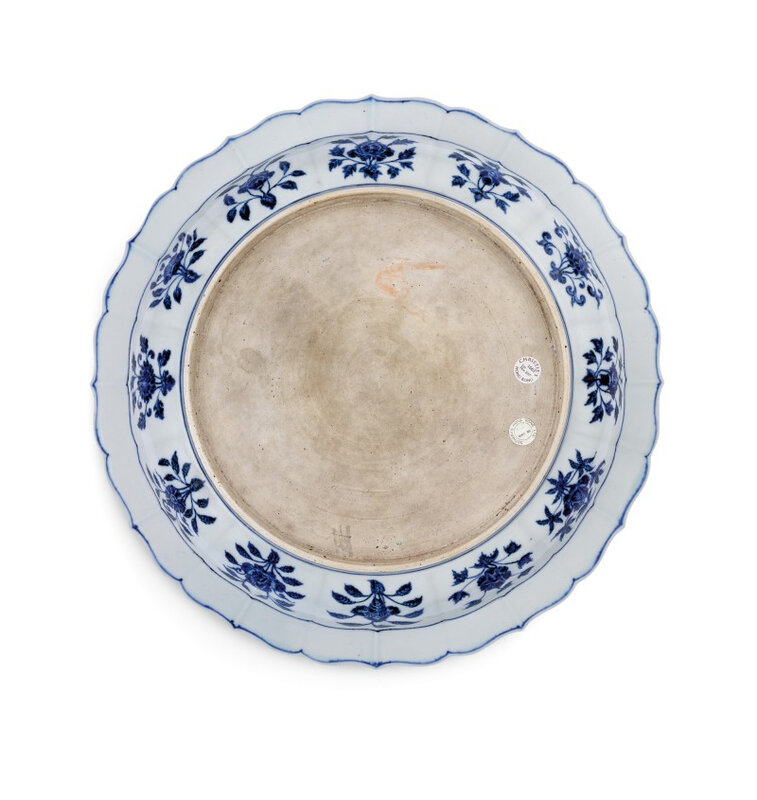An exceptional and rare blue and white barbed 'grape' charger, Ming Dynasty, Yongle Period (1402-1424)
Lot 3612. An exceptional and rare blue and white barbed 'grape' charger, Ming Dynasty, Yongle Period (1402-1424); 44 cm. Estimate: 14,000,000 - 18,000,000 HKD. Lot sold: 17,115,000 HKD. Courtesy Sotheby's.
superbly painted on the interior in rich cobalt-blue tones with three bunches of grapes borne from a gnarled vine issuing broad furled leaves detailed with veining and delicately coiling tendrils, the cavetto subtly lobed in twelve panels and depicting rose, chrysanthemum, lotus, mallow, camellia and peony, alternating with leafy lingzhi sprigs, the barbed rim encircled by band of a blackberry-lily scroll, the reverse with similar floral sprays within the bracket-lobed panels, the base unglazed.
Property from a Distinguished Private Collection.
Note: The elegant design of this dish represents one of the great classic patterns of the Yongle period that demonstrate the achievement of Jingdezhen’s potters and painters in the early Ming dynasty. Under the Yongle Emperor not only did the quality of porcelain and stylistic sophistication reach unprecedented heights, its value to the court also evolved from that of an exquisite practical item of the imperial household to becoming a commodity with economic and diplomatic potential to the Emperor.
The Yongle Emperor was an outward-looking monarch, and his reign was marked by numerous official expeditions abroad. Large dishes painted in underglaze blue were made at the imperial kilns in Jingdezhen, Jiangxi province, where production was carefully monitored. Porcelains here were produced for the court, its specifications defined and quality monitored by the court, and its distribution organised by the court and assured through official channel. While quality control was stringent in this period, so as to make porcelains impeccable, designs were jealously guarded, so no copies could be made by lesser kilns that might be confused with the original and in this way harm the repute and prestige of the product.
Dishes painted with this motif, always featuring three clusters of grapes issuing from a single stem, vary in few but distinct ways: the sides are either rounded or lobed and the rims are straight or barbed. Among surviving examples, the present piece is particularly outstanding for its fine potting, smooth, tactile glaze and lush fruit pattern that beautifully displays the characteristic ‘heaping and piling’ of the cobalt blue – a much-copied trademark of imperial blue and white porcelains from the early Ming dynasty.
Dishes of this design made for the court include one from the Qing court collection and still in Beijing, illustrated in Geng Baochang ed., Gugong Bowuyuan cang. Ming chu qinghua ci [Early Ming blue and white porcelain in the Palace Museum], Beijing, 2002, vol. II, pl. 133, together with a slightly smaller circular dish of this design, pl. 135.
After an interruption in the Hongwu reign, the Yongle Emperor re-established relations with the Timurid ruler Shahrukh Mirza (r. 1405-1447), which led to frequent mutual exchanges of luxury goods between the two empires, including blue and white porcelains. A dish of this design formerly in the Ardebil Shrine and now in the National Museum of Iran, Tehran, is illustrated in John Alexander Pope, Chinese Porcelains from the Ardebil Shrine, Washington D.C., 1956, pl. 38. A similar dish is also found in the Topkapi Saray Museum, Istanbul, illustrated in Regina Krahl, Chinese Ceramics in the Topkapi Saray Museum, Istanbul, London, 1986, vol. II, pl. 605; a further example is in the Musée Guimet, Paris (accession no. MA1645), illustrated in Daisy Lion-Goldschmidt, Ming Porcelain, Fribourg, 1978, pl. 25; another one from the collection of Walter Sedgwick is now in the British Museum, London (accession no. 1968,0422.27), included in Jessica Harrison-Hall, Catalogue of Late Yuan and Ming Ceramics in the British Museum, London, 2001, pl. 3:36; and another barbed charger included in the exhibition Tianminlou qinghua ci tezhan [Special exhibition of blue and white porcelain from the Tianminlou collection], Shanghai Museum, Shanghai, 1996, cat. no. 24.
Grand plat à décor de grappes de raisin, feuilles et vrilles, 14e siècle, dynastie Ming (1368-1644), porcelaine à décor bleu et blanc. Hauteur : 7,8 cm, Largeur : 44,5 cm. Paris, musée Guimet - musée national des Arts asiatiques. Photo © RMN-Grand Palais (MNAAG, Paris) / Thierry Ollivier
Porcelain serving dish with a bracketed rim and underglaze blue decoration, Ming dynasty, Yongle period (1403-1424). Diameter: 41 cm Height: 7 cm. Bequeathed by Mrs Walter Sedgwick. Registration number: 1968,0422.27. © The Trustees of the British Museum.
The grape motif is comparatively rare on Chinese works of art as the fruit was mainly grown in Central Asia. It was first introduced in the Tang dynasty when the Silk Road enabled a close contact with this region, and re-appeared in the Yuan dynasty, when China again had many economic and cultural ties with the West, before becoming increasingly popular during the Yongle reign.

/https%3A%2F%2Fprofilepics.canalblog.com%2Fprofilepics%2F1%2F0%2F100183.jpg)
/https%3A%2F%2Fstorage.canalblog.com%2F03%2F02%2F119589%2F96711876_o.jpg)
/https%3A%2F%2Fstorage.canalblog.com%2F11%2F31%2F119589%2F94773502_o.jpg)
/https%3A%2F%2Fstorage.canalblog.com%2F20%2F83%2F119589%2F94772815_o.jpg)
/https%3A%2F%2Fstorage.canalblog.com%2F26%2F72%2F119589%2F75604929_o.jpg)
/https%3A%2F%2Fstorage.canalblog.com%2F59%2F60%2F119589%2F26458628_o.jpg)








/image%2F1371349%2F20240416%2Fob_2a8420_437713933-1652609748842371-16764302136.jpg)
/image%2F1371349%2F20240414%2Fob_83ee65_2024-nyr-22642-0954-000-a-blue-and-whi.jpg)
/image%2F1371349%2F20240414%2Fob_15808c_2024-nyr-22642-0953-000-a-blue-and-whi.jpg)
/image%2F1371349%2F20240414%2Fob_e54295_2024-nyr-22642-0952-000-a-rare-blue-an.jpg)